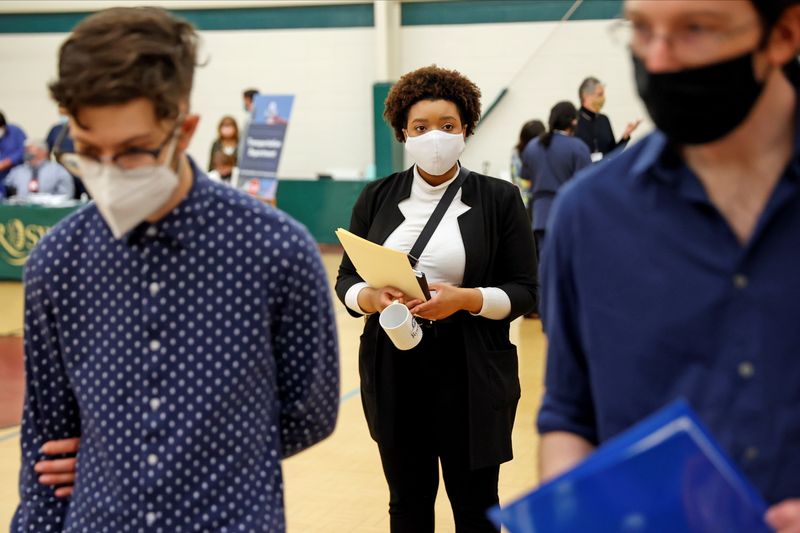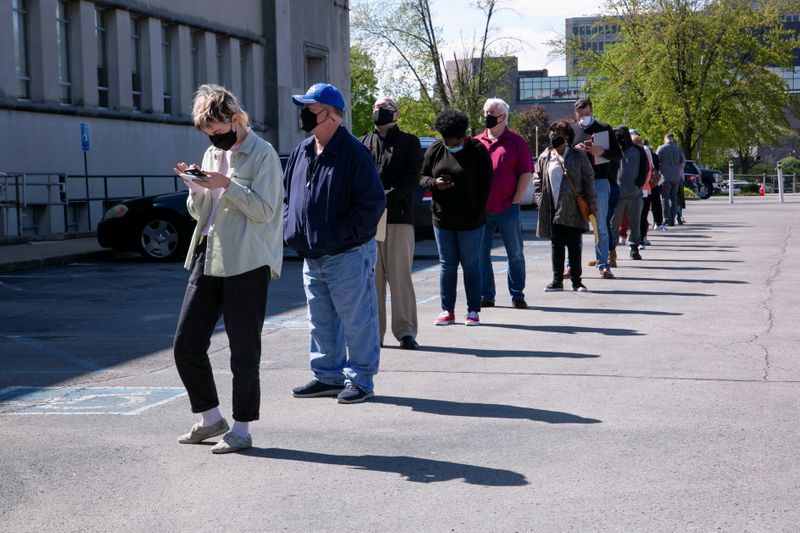By Lucia Mutikani
WASHINGTON (Reuters) - The number of Americans filing new claims for unemployment benefits dropped to a 14-month low last week as companies held onto their workers amid a growing labor shortage that helped to curb employment growth in April.
The scramble for workers comes as the reopening economy is experiencing a boom in demand, resulting in widespread shortages of inputs at factories and fanning inflation. Producer prices increased more than expected in April, leading to the biggest annual gain since 2010, other data showed on Thursday.
The worker shortage is despite nearly 10 million Americans being officially unemployed, a disconnect that economists expect will resolve in the coming months as increased vaccinations ease COVID-19 stress and enhanced unemployment benefits expire, allowing some workers to return to the labor market.
"With demand for workers high and layoffs relatively low, we should see strong hiring in the months to come, as barriers to employment, such as lack of childcare, lessen," said Robert Frick, corporate economist at Navy Federal Credit Union in Vienna, Virginia. "For many, especially low-wage workers, returning to a job is a puzzle in which several pieces, such as transportation, wage levels and benefits must fall into place."
Initial claims for state unemployment benefits dropped 34,000 to a seasonally adjusted 473,000 for the week ended May 8, the Labor Department said. That was the lowest since mid-March 2020, when mandatory closures of nonessential businesses were enforced to slow the first wave of COVID-19 infections.
Economists polled by Reuters had forecast 490,000 applications for the latest week. The decrease in claims was led by Michigan, New York and Florida.
Claims have dropped from a record 6.149 million in early April 2020, but remain well above the 200,000 to 250,000 range that is viewed as consistent with a healthy labor market.
Some economists believe the enhanced unemployment benefits programs, including a weekly $300 government subsidy, could be encouraging some people to attempt to file a claim for assistance, though not every application is approved.
The economy created 266,000 jobs in April after adding 770,000 in March, which was partly blamed on the generous unemployment benefits. There are a record 8.1 million open jobs.
Several states in the South and Midwest, such as Tennessee and Missouri, that have unemployment rates below the national average of 6.1% have recently announced they will end federally funded pandemic unemployment benefits next month.
Economists cite the still-bloated jobless rolls as supporting the thesis that unemployment checks were keeping some workers home. There were 3.655 million people receiving benefits after an initial week in the week ended May 1, down 45,000 from the prior week. A total 16.9 million people were collecting unemployment checks under all programs at the end of April.
The government-funded benefits end in early September.
Richmond Federal Reserve president Thomas Barkin said on Thursday, "the question of how to unclog the labor market is going to be a critical one," in keeping the recovery on track.
Stocks on Wall Street rebounded on the claims data after declining for three straight sessions. The dollar was steady against a basket of currencies. U.S. Treasury prices rose.
DEMAND BOOM
The government has provided nearly $6 trillion in pandemic relief over the past year. More than a third of the population has been fully vaccinated, leading many states to lift most capacity restrictions on businesses.
The resulting pent-up demand is pushing against supply constraints. In another report on Thursday, the Labor Department said its producer price index for final demand rose 0.6% in April after surging 1.0% in March.
A 0.6% increase in the cost of services accounted for about two-thirds of the rise in the PPI. Services, which increased 0.7% in March, were last month driven by higher prices for portfolio management, airline tickets and food retailing as well as physician care.
Goods prices gained 0.6%, lifted by an 18.4% jump in steel mill products. In the 12 months through April, the PPI shot up 6.2%. That was the biggest year-on-year rise since the series was revamped in November 2010 and followed a 4.2% jump in March.
Part of acceleration in the PPI was due to last spring's weak readings dropping out of the calculation. The report followed on the heels of news on Wednesday that consumer prices increased by the most in nearly 12 years in April.
Though rising prices have spooked investors, the Federal Reserve has signaled it could tolerate higher inflation for some time to offset years in which inflation was lodged below its 2% target, a flexible average.
Fed Vice Chair Richard Clarida said on Wednesday it would be "some time" before the economy is healed enough for the U.S. central bank to consider scaling back its support. The Fed slashed its benchmark overnight interest rate to near zero last year and is pumping money into the economy through monthly bond purchases. Its preferred inflation measure, the core personal consumption expenditures (PCE) price index is at 1.8%.

"Each big inflation report for the next several months will test the Fed's approach to seeing through these issues it promises to be transitory," said Will Compernolle, a senior economist at FHN Financial in New York.
Based on the CPI and PPI data, Goldman Sachs (NYSE:GS) is forecasting that core PCE increased 0.49% in April and 3.38% year-on-year.
